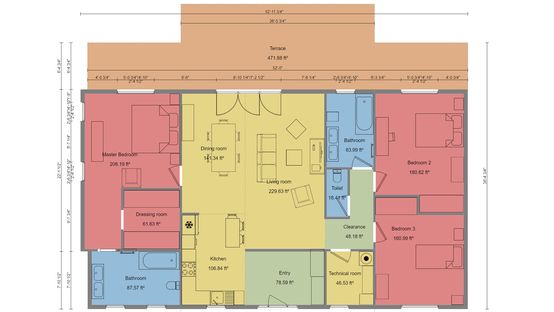The construction industry throws a lot of terminology around — so much so that it can be virtually impossible to keep up if you’re relatively new to the field. No worries, though — this article is going to help you with one common and extremely important piece of construction vocabulary: the construction takeoff.
Below, we discuss takeoffs, how they’re used, how they are helpful to you and how to create great ones. Keep reading to learn everything you need to know. When you’re done, you’ll sound like the seasoned construction, remodeling and architectural expert you were always destined to be.
What Is a Construction Takeoff?
What is a takeoff in construction? A construction takeoff isn’t a physical thing. Instead, it’s a process. More specifically, it is the process in which you determine how much of each involved material you will need to complete a given construction project.
You may also see construction takeoffs referred to as quantity takeoffs or material takeoffs. These are all the same thing, and they play a vitally important role in the vast majority of construction projects.
While the definition of construction takeoff is relatively simple to understand, the processes and actual execution of takeoffs are anything but simple.
Uses of Construction Takeoffs
Whether you hire out construction takeoff services or do your own, you will find that construction takeoffs are an incredibly useful tool for your business — in more ways than one. Here are some common uses for material takeoffs.
Bids
Bidding on construction jobs is hard enough, but when you start trying to bid based on your best guess on the amounts of materials you will need for the project, it can feel downright impossible. That’s because you will either overestimate and lose the job or underestimate and end up breaking the project budget. Construction takeoffs are designed to solve this problem by giving you a relatively exact idea of the materials you will need before you submit a bid.
Estimates
If you’ve been in the construction industry for decades and keep up with material prices and industry trends, you may be able to guess on the material amounts when you do project estimates. But the vast majority of construction professionals rely on a takeoff before they give any sort of price estimate.
Material quantities
Whether you’re in the middle of a job or doing a job that came to you with no estimation necessary, you may find yourself needing to know how much of particular materials to buy. Construction takeoffs are the perfect solution.
Challenges of Construction Takeoffs
If you aren’t using construction takeoff software or takeoff services for construction projects you’ve won, you may find the process of completing a takeoff somewhat difficult.
Even if you’re working from a detailed construction takeoff template, you may find that the tedious by-hand nature of material measurement is not only mind-numbing but ripe with potential for errors. And errors can cost you not just in unforeseen material costs, but in reputation and client satisfaction.
Fortunately, these challenges are easily overcome with modern technology. Various pieces of software can make the takeoff process much simpler and keep it more free of errors.
Benefits of Construction Software for Takeoffs
The construction takeoff process is complicated. There’s no denying that, and it’s the reason many construction companies simply skip this essential step — and lose money because of it.
But that doesn’t have to be you. You can find plenty of construction takeoff software to make the process much easier. If you choose the software route, expect the following benefits:
Accuracy
Anything done by hand holds the potential for human error. And while errors can still happen when you’re using material takeoff software, they are much less likely.
Speed
Without software, the construction takeoff process is tedious, and that means it takes a lot of time. In this industry, time is money, and the right construction takeoff software will save you plenty of time if it includes smart and powerful estimation features.
Standardized costs
Choosing a single takeoff software to use across your company puts everyone on the same page when it comes to project and material costs. The prices come straight into the software from a central database.
Data transfer
High-quality construction takeoff software will integrate seamlessly with your other pieces of tech — your estimation software, your CRM and your project management system. Error-free data transfer cuts down on mistakes throughout all phases of construction.
Financial savings
Takeoff software saves you time, and that means you can make more bids. When you’re making more bids, you’re likely to get more work. On top of the extra revenue from more jobs, you’re also saving on unforeseen material costs when you use software to generate more accurate bids.
Creating a Successful Construction Takeoff
We have already established that construction takeoffs are incredibly helpful tools for construction companies, but there is a right way and a wrong way to do these estimates. Do them the wrong way, and you might as well not have done them at all.
Here’s what you need to do to ensure that you have created a successful construction takeoff:
Measure and re-measure
When you’ve concluded the final step in the construction takeoff process, you will be tempted to sit back in your chair and say that the takeoff is concluded. But if you do that, you will have skipped an essential final step. And that step is a big one: Do it all again.
It sounds like a lot of work, but construction takeoffs are complex, and mistakes can — and often do — happen. Going back and re-measuring every material can help you find the mistakes you made on the first go-around. Correcting those mistakes could save you unbelievable amounts of money.
Maintain accurate drawings and plans
If there’s a problem with your construction drawings or building plans, you won’t be able to catch the mistakes by simply doing another takeoff. That’s because the takeoff is based on the plans themselves, so if the plans are inaccurate, the takeoff may be accurate for the plans but not for the project in real-life.
So, it’s imperative that you maintain accurate drawings and plans. Check that they’re accurate down to the last detail and check them again before you do your construction takeoff.


Create a list
Lists are a home builder’s best friend. There are so many moving parts to material takeoffs that it’s easy for one to simply get lost in the shuffle — only to resurface when you’re short on materials and edging dangerously close to the upper limits of the project budget.
Don’t wait another minute — create a list of every single part of the project that will require materials of some kind. Run the list by your colleagues, and re-check it yourself.
Utilize helpful software
We’ve already covered the benefits of construction takeoff software, so you understand how it can be so helpful in completing your takeoff process. Yes, these pieces of software cost some money in most cases, but the money they can save you on a single project — in the form of saved time and avoided errors — will more than make up for the initial cost.
Construction Takeoff Process Breakdown
Whether you are doing manual construction takeoffs or using software to complete them, you will need to have a basic understanding of how to actually do a takeoff. Here are the key steps in calculating your construction material costs.
Measure circuits
One of the most important measurements you will need to take is that of the circuits involved in the home or building project. This also happens to be one of the most difficult parts to measure because wires are often bundled together in such close proximity that it can be difficult to get an accurate measurement.
Before you begin measuring the circuits on the construction drawings, check the scale for each drawing. Make sure you are measuring according to the scale. And if you are using documents that were copied from original blueprints, make sure that they weren’t copied at a smaller or inaccurate scale.
A measuring wheel will be the most accurate way to measure the circuits in any given set of construction drawings, but if you’re doing quick and rough calculations, an architectural ruler or scaled measuring tape will also do the trick.
Count symbols
The construction drawings or blueprints you’re working from should include symbols for each component within the home or commercial building. To complete your construction takeoff, you’re going to have to count those symbols.
Check the key to make sure you’ve correctly understood what each symbol means, and take your time counting each and placing the totals into different categories. It’s often helpful to use a clicking tally counter and mark each symbol with a colored pencil after you have counted it.
Calculate takeoff
With your symbol counts and circuit measurements in hand, you’re ready to start calculating the takeoff price. Don’t forget to use current market prices to calculate the estimated costs, along with a pricing buffer that would account for any unpredicted fluctuations in the prices.
Final Thoughts
Construction takeoffs are a critical part of any construction project, but because they can be so difficult to complete, many companies skip them or rely on “best guess” estimates. These practices can lead to hundreds of thousands of dollars wasted on materials, as well as broken project budgets.
There’s an intermediate solution that sits between not doing takeoffs and doing them manually. It’s construction takeoff software like Cedreo with CostCertified integration. While Cedreo is primarily a floor plan software, it allows you to quickly create floor plans at scale and get exact measurements of all involved materials. The CostCertified integration then takes your floor plans to give you exact construction estimates.
Those are the building blocks of a successful construction takeoff, and Cedreo offers a lot more than those features in a user-friendly, fully online floor plan software trusted by thousands of construction professionals. Try Cedreo today.



